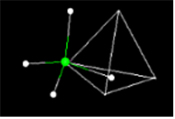Introduction to MathMol
People have always been fascinated with objects that can't be seen with the naked eye. One only has to observe students taking their first look at microscopic organisms through a microscope, or the rings of Saturn through a telescope.
We are now just at the threshold of being able to visualize molecules. Crystallographic techniques, advanced scanning devices and sophisticated software programs have provided scientists with tools that can provide realistic models for many molecules. The power of the computer is fast approaching the point at which we will soon be able to model molecules and their motion with a fair degree of accuracy.
Most students get their first exposure to atomic and molecular structure in elementary school by building model atoms or simple crystal lattices such as salt. In middle school, textbooks begin to introduce simple organic molecules, more advanced crystal structures and water and ice structures. Although all schools now consider the microscope a necessity in the classroom to view microscopic objects, few schools have provided tools for students to visualize molecules. What is perhaps not known to many educators is that time and effort is all that is necessary --provided the school has a computer and link to the internet
During the past few years scientists have provided several excellent molecular viewers to the scientific community. Several of these programs are ideally suited for use in K-12 education. These programs are public domain and simply require knowledge of use and a fairly modern computer (something that most schools now have)
There is still much controversy concerning what grade level molecular visualization should begin. Many educators feel that molecular structure should not be introduced until high school, since it may confuse students understanding of macroscopic processes. But other educators feel that middle school is actually an ideal starting point for introducing molecules. Project MathMol aims to target middle school students, introducing basic molecular concepts and linking them to familiar mathematical topics. We hope teachers will integrate some of the MathMol activities into their mathematics and/or physical science curriculum. Considering the importance of molecular concepts for the 21st century it is important to provide a strong foundation for students as early as possible.MATHMOL TEXTBOOK V 3

Table of Contents
- Introductory Comments
- What is Molecular Modeling?
- Why is Molecular Modeling Important?
- What do Some Common Molecules Look Like?
- Where's the Math in MathMol?
- Carbon 3 Ways
- How to View Molecular Structures in Class or at Home
- MathMol Library of Structures
Interactive Activities
- Activity 1: Measuring length and distance at the molecular level
- Activity 2: Geometry-of-1-Dimension
- Activity 3: Geometry of 2- Dimensions
- Activity 4: Geometry of 3-Dimensions
- Activity 5: Introduction to Molecular Modeling using Jsmol
- Activity 6: The Geometry of Crystals
- Activity 7: Summary Sheet by Students
- Activity 8: What is the Geometry of the Methane Molecule
- Activity 9: Geometry of the Crystal Structure of Ice
- Activity10:Geometry of the Benzene Molecule
Appendix
Interactive Activities